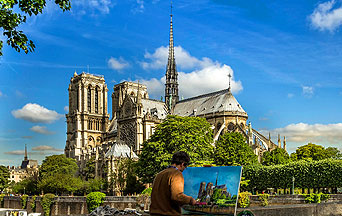
There is an apocryphal story about a medieval sculptor finishing a statue to be put in a niche. An onlooker asked, “Why are you finishing the back of the statue. No one will ever see it.” The sculptor responded, “God will.”
The outpouring of charitable donations to rebuild the Cathedral of Notre-Dame de Paris could use a little of this sculptor’s spirit. Apparently, some people are only considering what others see.
A Public Response to the Emergency
The fire was still blazing on April 15, 2019, when the news media began to carry reports of the massive pledges for the rebuilding effort.
Such events present very public opportunities to improve corporate images. According to Bloomberg, over a billion euros were promised. Donors included the parent company of Gucci (€100 million), French energy company Total (€100 million), the company owning Louis Vuitton (€200 million) and the foundation set up by the family that owned L’Oréal (€200 million).
With each announcement, reporters commented on how such benevolence would restore the cultural treasure, no matter the cost.
The Limits of Benevolence
Before the fires cooled, the debate was already raging about the competing ideas for the restoration. Some argue that the reconstruction should be as close to the original as possible. Others posit the idea that the medieval masterpiece should reflect modern life and culture. The original, the modernists argue, reflected the values of its time; the rebuilding should highlight present values.
Eternal and Natural Law: The Foundation of Morals and Law
The controversy appears to have cooled the ardor of the prospective donors. They want to approve plans and contracts before they send their money.
Who Owns the Cathedral?
Even before the fire, there was controversy about financing needed repairs and maintenance. In 1905, the French government confiscated the Cathedral and allows the Church to use the usurped property. Since then, the French Ministry of Culture has been responsible for its upkeep.
Over time, the building deteriorated on government “care.” In 2017, concerned citizens founded an organization to raise funds for much-needed preservation. The information on the web site of the Friends of Notre-Dame de Paris still reflects the pre-fire condition of the Cathedral. The list of needs included cracks in the nearly 100-meter-high spire, the stability of the flying buttresses, repairing gargoyles (some of which had fallen) and strengthening the leading of the stained glass windows.
Cleaning Up
The early work required for restoration is not glamorous. Fragile but undamaged areas need to be secured. Items that can be moved must be protected from further damage. Assessments of the building’s strength must be made, and areas in danger of collapse need to be supported.
Another unexpected concern is the destroyed roof that was covered in three hundred tons of lead. The heat of the fire released lead particles into the air and wind. Children living in the area could have dangerous amounts of lead in their bloodstreams.
Learn All About the Prophecies of Our Lady of Good Success About Our Times
These concerns are serious, urgent and costly. They cannot wait for the contracts and plans demanded by wealthy self-aggrandizers. One donor wants to pay for enduring features, but not for the invisible, yet more pressing needs of cleaning and stabilization. Another wants to ensure that the craftsmanship will be up to their artistic standards. Left unsaid is the distrust that the French government will waste vast amounts on the stifling processes of bureaucracy.
Thus, no money has yet come from the big donors. According to Michel Picaud, the president of the Friends organization, all the donations to date have come from small donors. Before the fire, 90 percent of the funds raised by the organization were small donations from Americans. The first post-fire check for €3.6 million euros ($4.1 million) was transferred early in June.
God’s Standards of Benevolence
All of this discussion calls to mind the nature of charity itself.
Holy Scripture is quite specific about the ideal form of benevolence. According to 1 Timothy 1:5, true charity comes, “from a pure heart, and a good conscience, and an unfeigned faith.”
Saint Paul amplifies the nature of a pure heart in his famous discourse, found in 1 Corinthians 13. “And if I should have prophecy and should know all mysteries, and all knowledge, and if I should have all faith so that I could remove mountains, and have not charity, I am nothing. And if I should distribute all my goods to feed the poor, and if I should deliver my body to be burned, and have not charity, it profiteth me nothing. Charity is patient, is kind: charity envieth not, dealeth not perversely; is not puffed up.”
Science Confirms: Angels Took the House of Our Lady of Nazareth to Loreto
The companies that pledged vast sums to rebuild Notre-Dame de Paris appear to be far more interested in worldly acclaim than any desire to build up treasures in Heaven. The utilitarian prejudices of the modern world would hold that their motivations are unimportant. The critical point, they would argue, is that their resources assist the reconstruction effort. In their minds, the Cathedral exists only as a cultural resource. Any divine purpose is beside the point—or perhaps even an inconvenience.
Perhaps one of the lessons to be learned is the way that religion is treated by the world—useful enough to be tolerated until it becomes too troublesome. Then, all pledges are put on hold. If only they would have the spirit of the medieval sculptor who believed that human giving is not made to be seen by men but by God.

